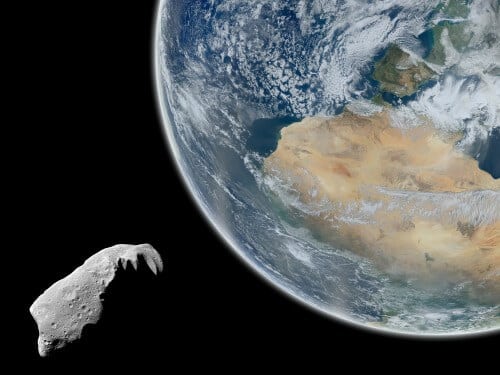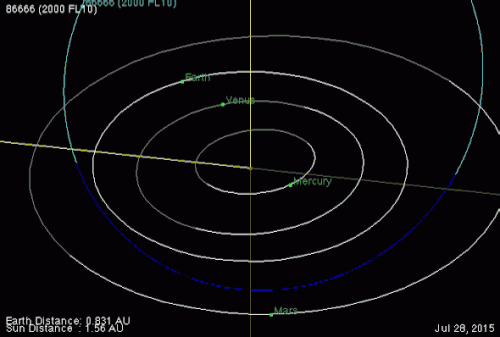NASA says that the asteroid is under radar surveillance like all large asteroids whose orbit brings them close to Earth, but the danger of an asteroid of a size that would be a threat to Earth is small (0.01% in the next century)

NASA announced last night that a large asteroid, known as 86666 (2000 FL10), whose diameter is estimated between 1.4 and 2.6 kilometers will pass 25 million kilometers from Earth tomorrow (Saturday), 10/10/15. There is no need to be alarmed, it is about half way to Mars, when the two planets are at their closest point, but also in an asteroid many times larger than most of the asteroids that pass by the Earth, so the scientific interest in it is great.
The term "asteroid will pass near the Earth" is of course a relative term. Explanation: Near-Earth asteroids and their fragments approach even to distances much smaller than the distance to the Moon, and in some cases even several tens of thousands of kilometers, And twice a year they even hurt him, but usually these are small rocks, up to several tens of meters in diameter. But this time it is a particularly large rock, so even a passage at a distance of 25 million kilometers, or 67 times the distance from the Earth to the Moon, is of interest to the scientists.
But still, the asteroid is of interest to astronomy researchers. NASA says that this is a near-Earth asteroid 15 times larger than any other asteroid that is currently on the radar.

The asteroid, as its name suggests, was discovered in March 2000 by the Catalina Observatory, and it is similar in dimensions to the Apollo asteroid numbered 1862 and which was previously identified as a potential threat object (PHO). This definition included asteroids whose orbits create the potential to approach Earth and which could cause great damage if they collided. Any such asteroid that comes within 7 million kilometers of Earth is considered a PHO.
However, according to NASA's Near-Earth Object Program, no observable asteroid or comet is expected to reach such a threatening distance and cause fear of a collision in the foreseeable future. "We know all the dangerous asteroids and there is a 0.01% chance of hitting the Earth in the next hundred years" says the NASA website.
A moving asteroid dwarfs asteroid 2014-YB35, which passed at a much closer distance - 4.5 million km from Earth on May 30.
About two months ago, NASA was forced to issue an official announcement And in it he dismissed the rumors according to which a large asteroid will collide with the Earth in the second half of September.
About two weeks ago, NASA and the European Space Agency signed a joint agreement for the assessment of impact and deflection of asteroids (AIDA). As part of the program, two asteroids will be studied: Didymus and the moon Didamon, in order to find the best ways to prevent possible damage to the Earth.
The issue of asteroid threats will be discussed during the next week at the International Astronautical Association (IAC) conference that will open this Monday in Jerusalem and has not been canceled despite the security tension (see news later today).
More of the topic in Hayadan:

13 תגובות
To bring a moon of Jupiter to Mars you need the energy of about 50 billion nuclear bombs. When the moon hits Mars it may release energy of about the same order of magnitude, raising the temperature of Mars by several thousand degrees.
It already sounds simpler to me to settle on Venus (the gravity there is almost the same as on Earth, it's hot there but not thousands of degrees).
One percent? in disgust…
Well we'll have to move one of Jupiter's moons 🙂
Update me when it has already passed!!? Thanks ?
Apart from simulating an asteroid interception system, which is within the capabilities of today's technology, at its edge, NASA does nothing to promote the issue. We are able to reach the distance of this asteroid in 5 months if I am not mistaken. Maybe a year and I'm wrong. I would be worried about this proximity at times to come. And does not understand how the world is busy with wars and such a worrying issue is not being addressed. It won't be easy to destroy an asteroid. This is similar to the landing of the Philae probe on a hook, only here not 10 years away. This means that two bodies moving at about 30000 km/h should reach a relative speed of about 10 meters per second, then land on the asteroid and somehow either explode from the outside or drill.
If, as in the movie Armageddon, quarrying is required, I don't really understand, so it complicates the matter.
From such a distance, the hour has no meaning.
What time is Israel time?
On August 27, 2003 Mars reached the smallest distance from the earth in the next 60,000 years 55,758,006 km, probably the minimum distance in the graph refers to the current cycle otherwise it would not look like such a beautiful sinus
my father
The minimum distance from Mars is 75,280,000 km - that means the asteroid will pass a third of the way to Mars, not half way to Mars. source:
http://www.wolframalpha.com/input/?i=distance+earth+mars+on+2016-05-31
The mass of the entire asteroid belt - as a whole - reaches about 1% of the mass of Mars. for your information.
What time according to Israel time?
Snupkin
It seems to me that if we had the technology to drop asteroids on Mars in order to increase its mass, we would risk changing its orbit and possibly endangering the Earth.
Also if there is life or evidence of extinction on Mars, a meteor will wipe it out
Methods for capturing asteroids need to be developed.
If this is possible, it will be possible to put them into orbit and build space stations on them, extract raw materials from them for construction in space, maybe even direct them to Mars in order to increase its mass.
It's a shame that you can't intercept them in any case